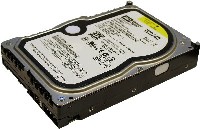Speed up your PC - Fit a 10,000 RPM system drive

Power uses go to great lengths to tweak their systems in order to experience improved performance but I'm here to tell you that all the registry tweaks and killing unnecessary services won't beat fitting a 10,000 RPM drive and loading your OS onto it.
The price per GB is high compared to 7,200 RPM drivesI'm a huge fan of fitting as much RAM into your PC as you can afford (up to the 4GB limit if you are running 32-bit Windows) but once your maxed out on RAM it can be tricky to find effective ways to boost performance. However, once simple way to give your PC an additional nitro kick is to fit a 10,000 RPM drive as your main system drive. And 10,000 RPM hard drives don't come much better than the Western Digital Raptor SATA drive. This is the king of speed when it comes to drives, and if you don't believe me, check out this AnandTech review (one of many that I could point you to, but they all say the same thing). Just as a simple comparison, take a look at the stats for a Raptor and a 7,200 RPM WD drive:
Western Digital Raptor WD740ADFD (74GB)
Average Latency: 2.99ms
Average Seek Time: 4.6ms
Average Write Time: 5.2msWestern Digital Caviar WD800BB (80GB)
Average Latency: 4.2ms
Average Seek Time: 8.9ms
Average Write Time: 10.9ms
[poll id=97]
Make no mistake, a 10,000 RPM drive will have an enormous impact on boot time and application load times.
When I mention 10,000 RPM drives to some people they worry that it's going to be a noisy beast to have spinning next to their head or in their living room. This is a misconception. The Raptor is no noisier than a 7,200 RPM drive.
The only drawback of the current lineup of 10,000 RPM drives is capacity. The price per GB is high compared to 7,200 RPM drives. The WD740ADFD works out a $2.16 per GB while the WD800BB works out at $0.52 per GB so you're paying a premium for that extra speed, but it's definitely worth it in the long run. Additionally, the drives are small - the largest Raptor is only 150GB. It's for this reason that I see these 10,000 RPM drives as being ideal as primary drives - you don't want to clutter them up with apps and paying over $2 a GB doesn't make sense for most apps out there (although programs that hammer the drive - like Photoshop - can benefit from a faster drive). You can then augment this fast drive with larger drives so you can install all the applications and games you want (of course, if you have cash to throw at your PC you could simply fit several Raptors!).
There's also scope for mirroring two Raptors using RAID 0 or RAID 0+1 if you want more speed. This is easy to set up nowadays as most motherboards now natively support RAID 0/0+1 (although I'll admit to not being a huge RAID fan on desktop PCs).
So, forget about silly registry tweaks and messing about with services, just install a 10,000 RPM drive.